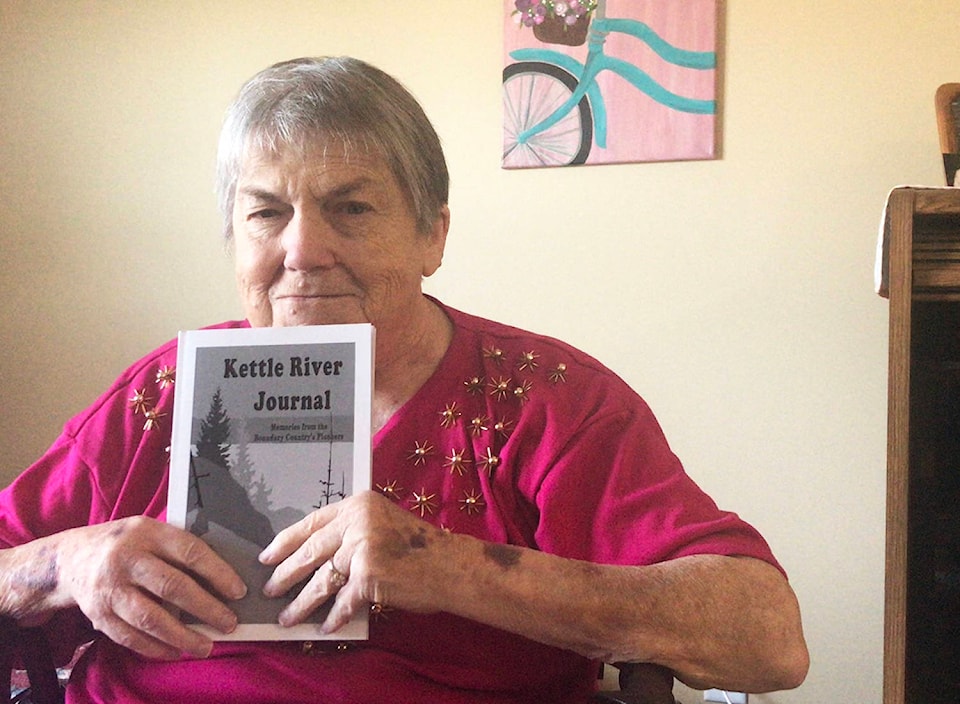Like the people whose stories she’s told in her Boundary Bulletin columns and in her book, Kettle River Journal, Rose Gobeil became a new character when she moved to the Boundary in the 1970s. Soon after she arrived, she became R. M. Simbrec – a detective, adventurer, journalist and listener who has scavenged the area over the decades since, piecing together histories from anecdotes and artifacts.
The stories Gobeil has shared have been published in the paper, bound for a book and adapted for the stage. Now, Gobeil is reprinting Kettle River Journal, originally published in 1997, so that some of those Boundary memories she’s shared can be catalogued in the national library and archives.
Many of Gobeil’s stories would be impossible to put together by just simply looking at historical documents and artifacts. The content of Kettle River Journal relies on Boundary storytellers, recounting the tales they they grew up with of neighbours and family.
“There’s an element of folklore in the stories she’s collected,” said Greg Nesteroff, a Kootenay-Boundary historian and writer/editor for Black Press. Nesteroff, who grew up in the region and became interested in local history as a child, said that without much of Gobeil’s work, “there are lots of things I still probably wouldn’t know.”
Specifically, Nesteroff points to a thorough catalogue of Boundary cemeteries and burial sites that Gobeil documented in the 1980s. “She’s done quite a service for us,” he said.
Gobeil’s foresight to record the stories of not just the places and artifacts but also of the people of the Boundary is what makes her work so valuable, Nesteroff said, and also more unique.
“She’s a storyteller,” he said. “She turns a simple object into something more.”
The tale behind her own pen name is one to be documented too. Gobeil came to the invented name “Simbrec” out of necessity and a duty to protect her family. Before moving to Grand Forks, her husband had worked as security at a mental hospital in the Lower Mainland, and they were wary of individuals coming to find him.
“It was known to happen,” Gobeil says.
All the while, the storyteller kept her family close to her writing. Simbrec, after all, is a combination of Simone (her daughter) and Breck (her son).
Like her writer identity, the sources for Gobeil’s stories in Kettle River Journal are often obscured too. Some tales are tied to places and dates, some tied to initials and very few attached to full names. Nevertheless, the writing brings her characters alive.
“They’re not [entirely] true stories by any means,” she says, explaining the anecdotal nature of tales passed down between generations. “They get added to, but [they’re still] stories about the Boundary.
Few history books would have unquoted sentences like, “In them days the whole countryside was a-crawlin’ with rattlers,” but that’s the voice that told Gobeil the story behind “Snake Tales” in Kettle River Journal, so that’s the voice she wrote it in. Same thing in “Spitting at the ceiling,” a story about 1930s Bridesville.
“There weren’t much to do in Bridesville,” the narrator begins, “so when we young fellers got paid we’d head for the hotel.”
“It’s the way it was told to me,” Gobeil says, explaining why she chose to keep her narrators’ voices alive.
“Spitting at the ceiling” was also one of the first stories that hooked Gobeil into digging into the region’s history, but the one tied with a place Gobeil loves most is “The hidden smelter.”
According to her research, a prospector built his own smelter up the North Fork more than 100 years ago, creating “a monument to one man’s stubbornness and tenacity.” The prospector apparently didn’t trust the big smelter in Grand Forks.
“You just feel you can feel it,” Gobeil says of the stories tied to that location. “You feel at peace. That’s the only way I can [explain it].”
But when Gobeil first ventured up the dirt roads leading to the hidden smelter (without a map, phone nor compass — she still only relies on memory and some accidental extra exploring to find where she’s trying to go), there was a shack there too. It’s gone now. Like some of the grave markers she’s used to find stories and the people themselves who shared their memories with her.
That artifacts are disappearing, however, does not mean that there’s nothing left to find.
Gobeil is still hunting for the resting place of a steam engine once used at the Phoenix mine site. She suspects its sunk deep into a tailings pond up there, maybe covered in sediment.
“I’ve heard three men that have sworn that it was in there,” she says.
“I’d love to just dive in!”
